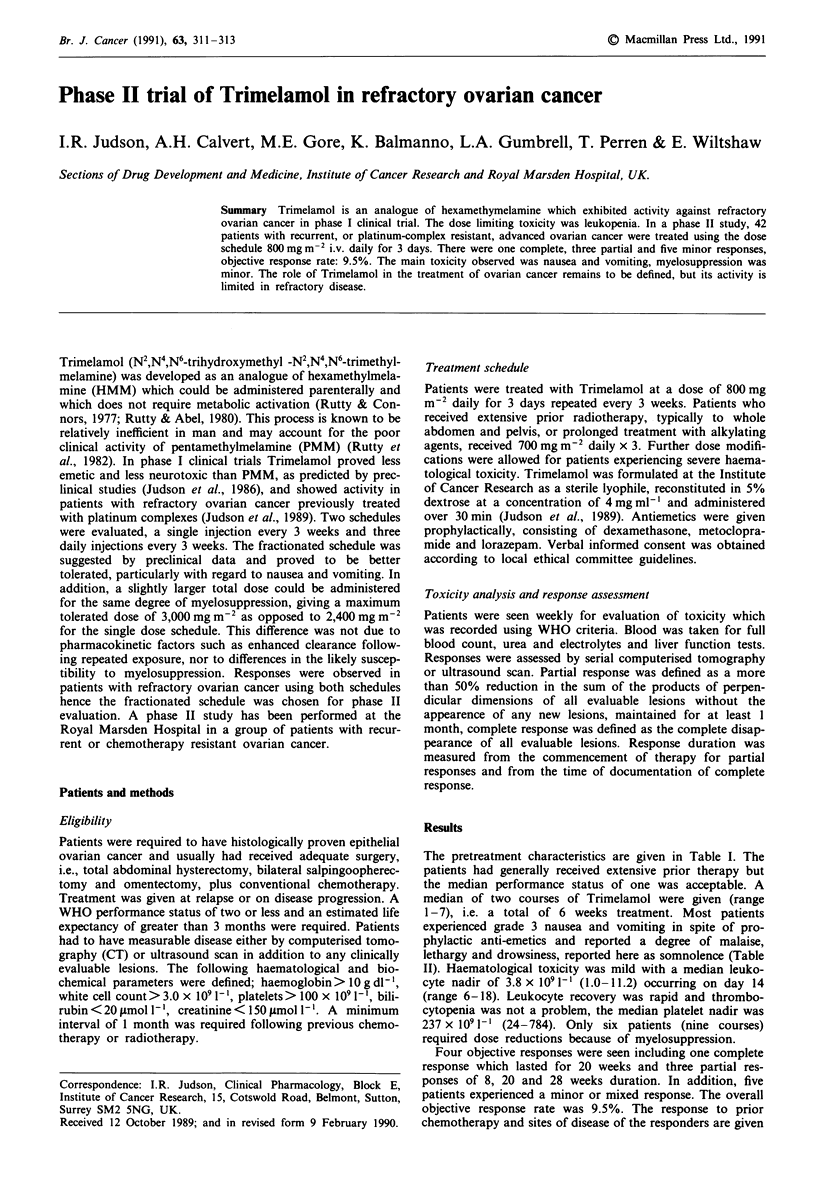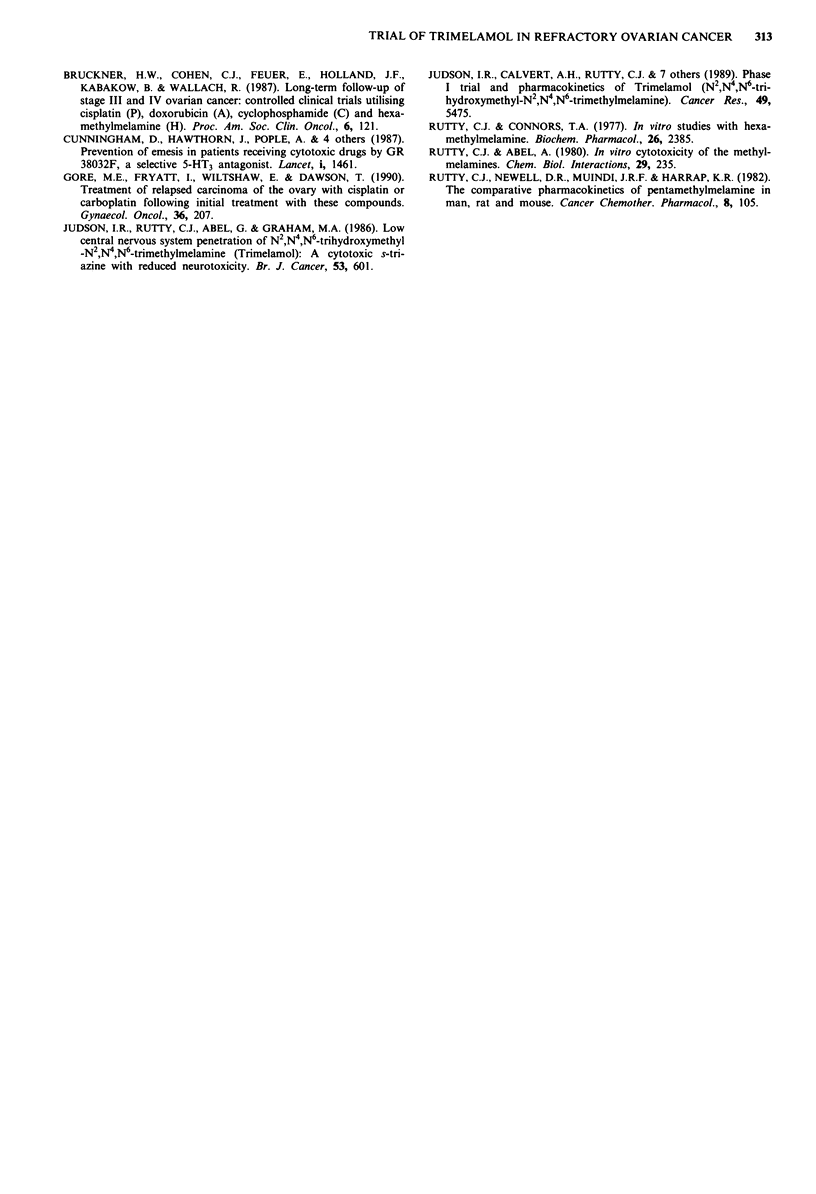Abstract
Trimelamol is an analogue of hexamethymelamine which exhibited activity against refractory ovarian cancer in phase I clinical trial. The dose limiting toxicity was leukopenia. In a phase II study, 42 patients with recurrent, or platinum-complex resistant, advanced ovarian cancer were treated using the dose schedule 800 mg m-2 i.v. daily for 3 days. There were one complete, three partial and five minor responses, objective response rate: 9.5%. The main toxicity observed was nausea and vomiting, myelosuppression was minor. The role of Trimelamol in the treatment of ovarian cancer remains to be defined, but its activity is limited in refractory disease.
Full text
PDF


Selected References
These references are in PubMed. This may not be the complete list of references from this article.
- Bermudez J., Boyle E. A., Miner W. D., Sanger G. J. The anti-emetic potential of the 5-hydroxytryptamine3 receptor antagonist BRL 43694. Br J Cancer. 1988 Nov;58(5):644–650. doi: 10.1038/bjc.1988.277. [DOI] [PMC free article] [PubMed] [Google Scholar]
- Blackledge G., Lawton F., Redman C., Kelly K. Response of patients in phase II studies of chemotherapy in ovarian cancer: implications for patient treatment and the design of phase II trials. Br J Cancer. 1989 Apr;59(4):650–653. doi: 10.1038/bjc.1989.132. [DOI] [PMC free article] [PubMed] [Google Scholar]
- Cunningham D., Hawthorn J., Pople A., Gazet J. C., Ford H. T., Challoner T., Coombes R. C. Prevention of emesis in patients receiving cytotoxic drugs by GR38032F, a selective 5-HT3 receptor antagonist. Lancet. 1987 Jun 27;1(8548):1461–1463. doi: 10.1016/s0140-6736(87)92208-2. [DOI] [PubMed] [Google Scholar]
- Gore M. E., Fryatt I., Wiltshaw E., Dawson T. Treatment of relapsed carcinoma of the ovary with cisplatin or carboplatin following initial treatment with these compounds. Gynecol Oncol. 1990 Feb;36(2):207–211. doi: 10.1016/0090-8258(90)90174-j. [DOI] [PubMed] [Google Scholar]
- Judson I. R., Calvert A. H., Rutty C. J., Abel G., Gumbrell L. A., Graham M. A., Evans B. D., Wilman D. E., Ashley S. E., Cairnduff F. Phase I trial and pharmacokinetics of trimelamol (N2,N4,N6-trihydroxymethyl-N2,N4,N6-trimethylmelamine). Cancer Res. 1989 Oct 1;49(19):5475–5479. [PubMed] [Google Scholar]
- Judson I. R., Rutty C. J., Abel G., Graham M. A. Low central nervous system penetration of N2,N4,N6,-trihydroxymethyl-N2,N4,N6,-trimethylmelamine (Trimelamol): a cytotoxic s-triazine with reduced neurotoxicity. Br J Cancer. 1986 May;53(5):601–606. doi: 10.1038/bjc.1986.102. [DOI] [PMC free article] [PubMed] [Google Scholar]
- Rutty C. J., Abel G. In vitro cytotoxicity of the methylmelamines. Chem Biol Interact. 1980 Feb;29(2):235–246. doi: 10.1016/0009-2797(80)90036-8. [DOI] [PubMed] [Google Scholar]
- Rutty C. J., Connors T. A. In vitro studies with hexamethylmelamine. Biochem Pharmacol. 1977 Dec 15;26(24):2385–2391. doi: 10.1016/0006-2952(77)90446-4. [DOI] [PubMed] [Google Scholar]
- Rutty C. J., Newell D. R., Muindi J. R., Harrap K. R. The comparative pharmacokinetics of pentamethylmelamine in man, rat, and mouse. Cancer Chemother Pharmacol. 1982;8(1):105–111. doi: 10.1007/BF00292880. [DOI] [PubMed] [Google Scholar]


